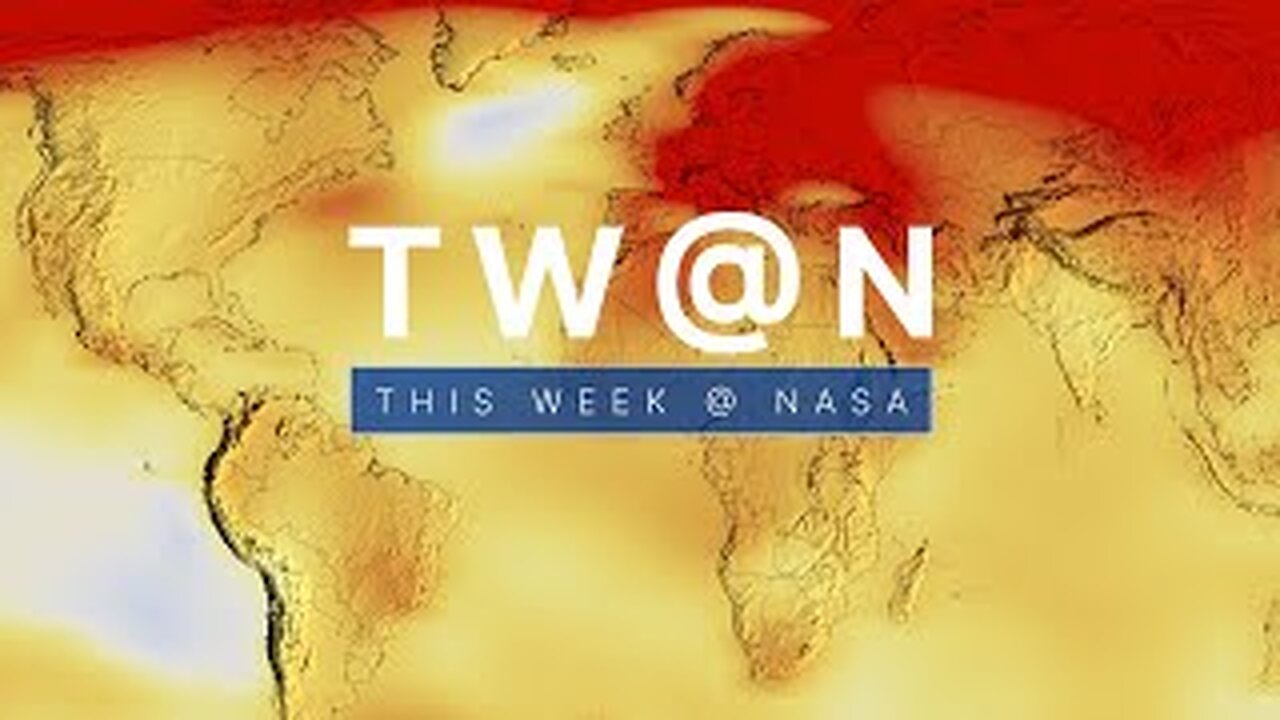Premium Only Content

Find out why July 2023 was a record-breaking month on This Week @NASA – August 18, 2023
Find out why July 2023 was a record-breaking month, a high-flying NASA aircraft is helping to study lighting, and making landings safe for flights of the future … a few of the stories to tell you about – This Week at NASA!
Link to download this video:
https://images.nasa.gov/details/Find%...
Video Producer: Andre Valentine and Haley Reed
Video Editor: Haley Reed
Narrator: Jesse Carpenter
Music: Universal Production Music
Credit: NASA
We know the Moon contains water, but, could future astronauts access and make use of it? That’s the goal. At NASA, we’re actively trying to answer that question. Once it lands at the lunar south pole, our PRIME-1 — Polar Resources Ice Mining Experiment-1 – will robotically sample and analyze ice from beneath the lunar surface, contributing to our search for water on the Moon
Dr. Joseph Lazio (NASA's Jet Propulsion Laboratory) shared how NASA’s Deep Space Network helps in our exploration of the Solar System and beyond in a webinar held with Night Sky Network member
About This Talk
Nearly every image of another planet that was taken by a NASA spacecraft has been transmitted to us through one or more antennas of NASA’s Deep Space Network (DSN). For almost the past 60 years, the DSN has been guiding spacecraft to their destinations across the Solar System, sending them commands for actions to take upon reaching their destinations, and receiving the data back from them. Moreover, the DSN is a science instrument in its own right. In this Webinar, I will review what the DSN is, how it enables NASA missions throughout the Solar System and beyond, and illustrate some of the scientific measurements that it makes on its own.
About Dr. Joseph Lazio
Joseph Lazio is the Interplanetary Network Directorate Scientist at the Jet Propulsion Laboratory, California Institute of Technology. He received his Ph.D. from Cornell University, was a National Research Council Research Associate at the U.S. Naval Research Laboratory, and was a Radio Astronomer on the staff of the Naval Research Laboratory, before joining JPL. He is the Project Scientist for the Sun Radio Interferometer Space Experiment (SunRISE) mission, and he has served as Project Scientist for the Square Kilometre Array (SKA); the Deputy Director of the Lunar University Network for Astrophysics Research (LUNAR), part of the NASA Lunar Science Institute; and the Project Scientist for the U.S. Virtual Astronomical Observatory. He also observes routinely with the world's premier ground-based radio telescopes, including the Expanded Very Large Array, the Very Long Baseline Array, and the Green Bank Telescope
A commercial resupply mission heads to the space station, a key piece of hardware for a future Moon mission is on the move, and another spacecraft gets ready to spread its wings in deep space … a few of the stories to tell you about – This Week at NASA!
Link to download this video: https://images.nasa.gov/details/A%20C...
Video Producer: Andre Valentine
Video Editor: Andre Valentine
Narrator: Andre Valentine
Music: Universal Production Music
Credit: NASA
We know the Moon contains water, but, could future astronauts access and make use of it? That’s the goal. At NASA, we’re actively trying to answer that question. Once it lands at the lunar south pole, our PRIME-1 — Polar Resources Ice Mining Experiment-1 – will robotically sample and analyze ice from beneath the lunar surface, contributing to our search for water on the Moon
Dr. Joseph Lazio (NASA's Jet Propulsion Laboratory) shared how NASA’s Deep Space Network helps in our exploration of the Solar System and beyond in a webinar held with Night Sky Network member
About This Talk
Nearly every image of another planet that was taken by a NASA spacecraft has been transmitted to us through one or more antennas of NASA’s Deep Space Network (DSN). For almost the past 60 years, the DSN has been guiding spacecraft to their destinations across the Solar System, sending them commands for actions to take upon reaching their destinations, and receiving the data back from them. Moreover, the DSN is a science instrument in its own right. In this Webinar, I will review what the DSN is, how it enables NASA missions throughout the Solar System and beyond, and illustrate some of the scientific measurements that it makes on its own.
About Dr. Joseph Lazio
Joseph Lazio is the Interplanetary Network Directorate Scientist at the Jet Propulsion Laboratory, California Institute of Technology. He received his Ph.D. from Cornell University, was a National Research Council Research Associate at the U.S. Naval Research Laboratory, and was a Radio Astronomer on the staff of the Naval Research Laboratory, before joining JPL. He is the Project Scientist for the Sun Radio Interferometer Space Experiment (SunRISE) mission, and he has served as Project Scientist for the Square Kilometre Array (SKA); the Deputy Director of the Lunar University Network for Astrophysics Research (LUNAR), part of the NASA Lunar Science Institute; and the Project Scientist for the U.S. Virtual Astronomical Observatory. He also observes routinely with the world's premier ground-based radio telescopes, including the Expanded Very Large Array, the Very Long Baseline Array, and the Green Bank Telescope
A commercial resupply mission heads to the space station, a key piece of hardware for a future Moon mission is on the move, and another spacecraft gets ready to spread its wings in deep space … a few of the stories to tell you about – This Week at NASA!
Link to download this video: https://images.nasa.gov/details/A%20C...
Video Producer: Andre Valentine
Video Editor: Andre Valentine
Narrator: Andre Valentine
Music: Universal Production Music
Credit: NASA
-
 21:06
21:06
Russell Brand
7 hours agoIT'S COMING
87.8K327 -
 21:26
21:26
Stephen Gardner
1 day ago🔥What JUST leaked out of Congress must be STOPPED NOW!
104K250 -
 53:25
53:25
tether
11 days agoStability and Freedom in Chaos: The Story of Tether USD₮ | Tether Documentary (USDT)
124K5 -
 56:44
56:44
VSiNLive
2 days agoFollow the Money with Mitch Moss & Pauly Howard | Hour 1
65.8K2 -
 36:50
36:50
Anthony Pompliano
2 days ago $15.66 earnedInvestors Are ALL-IN On Bitcoin
62.4K20 -
 32:19
32:19
SB Mowing
9 days agoA Backyard She’s NEVER Seen – Now Safe for the Kids to Play!
59.4K28 -
![[Day 26] CS Blast bounty baby](https://1a-1791.com/video/fwe2/8a/s8/1/Z/H/j/_/ZHj_w.0kob-small-Day-26-CS-Blast-bounty-baby.jpg) 2:09:11
2:09:11
ggezlol_tv
11 hours ago[Day 26] CS Blast bounty baby
91.6K3 -
 2:32:17
2:32:17
Sgtfinesse
10 hours ago💥Sunday Morning Hunt for Featherweight Artifact | New World PVP Server: Sclavia
93.1K4 -
 11:25
11:25
Film Threat
1 day agoLET'S DISCUSS THE 2025 OSCAR NOMINATIONS | Film Threat News
67.7K20 -
 13:07
13:07
DEADBUGsays
11 hours agoThe Southport Massacre, The Great British Cover-Up
57.1K36